|
|
|
 |
 |

 |
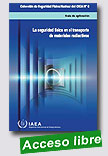 |
La Seguridad Física en el Transporte de Materiales Radiactivos
Colección de Seguridad Física Nuclear del OIEA, 2013, 55 p.
Puesto que el transporte tiene lugar en el dominio público y supone con frecuencia transbordos intermodales, es una fase potencialmente vulnerable del comercio nacional e internacional. La finalidad de esta guía es proponer un enfoque uniforme y coherente de la seguridad física.
El objetivo de esta guía es facilitar a los Estados orientaciones para el establecimiento, mantenimiento o refuerzo de un |
régimen de seguridad física 4 nuclear de los materiales radiactivos (comprendidos los materiales nucleares) a fin de protegerlos durante su transporte contra el robo, el sabotaje u otros actos dolosos que podrían tener, si se lograran, consecuencias radiológicas inaceptables. Desde el punto de vista de la seguridad física, se define un umbral para determinar qué bultos o tipos de materiales radiactivos es necesario proteger aplicando otras medidas además de las prácticas de gestión prudente. A fin de
reducir al mínimo la probabilidad de robo o sabotaje de materiales radiactivos durante su transporte es necesario aplicar una combinación de medidas para impedir, detectar o demorar tales actos y responder a ellos. Estas medidas se complementan con otras destinadas a recuperar los materiales robados y mitigar las posibles consecuencias, a fin de reducir aún más los riesgos.
Extraído de: http://www-pub.iaea.org/MTCD/Publications/PDF/Pub1348s_web.pdf
|
 |
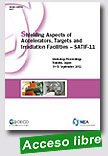 |
Shielding Aspects of Accelerators, Targets and Irradiation Facilities - SATIF-11
Nuclear Energy Agency (NEA), 08/10/13, 202 p.
Particle accelerators have evolved over the last decades from simple devices to powerful machines, and are having an increasingly important impact on research, technology and daily life. Today they have a wide range of applications in many areas including material science and medical applications. In recent years, new technological and research applications have helped to define requirements while the number of accelerator facilities |
in operation, being commissioned, designed or planned has grown significantly. Their parameters, which include the beam energy, currents and intensities, and target composition, can vary widely, giving rise to new radiation shielding aspects and problems.
Particle accelerators must be operated in safe ways to protect operators, the public and the environment. As the design and use of these facilities evolve, so must the analytical methods used in the safety analyses. These workshop proceedings review the state of the art in radiation shielding of accelerator facilities and irradiation targets. They also evaluate progress in the development of modelling methods used to assess the effectiveness of such shielding as part of safety analyses.
Extraído de:
http://www.oecd-nea.org/tools/publication?query=&div=&lang=&period=6m&sort=
title&filter=1#p7157
|
 |
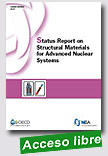 |
Status Report on Structural Materials for Advanced Nuclear Systems
Nuclear Energy Agency (NEA), 21/10/13, 107 p.
Materials performance is critical to the safe and economic operation of any nuclear system. As the international community pursues the development of Generation IV reactor concepts and accelerator-driven transmutation systems, it will be increasingly necessary to develop advanced materials capable of tolerating the more challenging environments of these new systems. The
|
international community supports numerous materials research programmes, with each country determining its individual focus on a case-by-case basis. In many instances, similar alloys of materials systems are being studied in several countries, providing the opportunity for collaborative and cross-cutting research that benefits different systems.
This report is a snapshot of the current materials programmes supporting the development of advanced concepts. The descriptions of the research are grouped by concept, and national programmes are described within each concept. The report provides an overall sense of the importance of materials research worldwide and the opportunities for synergy among the countries represented in this overview.
Extraído de:
http://www.oecdnea.org/tools/publication?query=&div=&lang=&period=
6m&sort=title&filter=1#p6409 |
 |
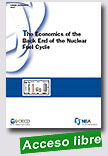 |
|
This report offers an appraisal of economic issues and methodologies for the management of spent nuclear fuel and high-level waste from commercial power reactors. It includes a review of different back-end options and current policies and practices, with a focus on the cost estimates for these options and the funding mechanisms in place or under consideration in OECD/NEA countries. A generic economic assessment of high-level estimates of back-end cost impacts on fuel cycle costs is undertaken for selected idealised scenarios, by means of a simple static model. Sensitivity analyses are conducted for the evaluation of uncertainties in major components and the identification of cost drivers. Since factors other than economics are an important part of the decision-making process, an analysis of the influence of key qualitative parameters in the selection of back-end strategies is also presented in this report.
Extraído de:
http://www.oecdnea.org/tools/publication?query=&div=&lang=
&period=6m&sort=title&filter=1#p7061
|
 |
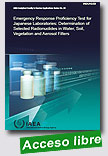 |
Emergency Response Proficiency Test for Japanese Laboratories: Determination of Selected Radionuclides in Water, Soil, Vegetation and Aerosol Filters
IAEA Analytical Quality in Nuclear Applications Series, 2013, 87 p.
After the accident at the Fukushima Daiichi nuclear power plant in March 2011, Japan requested the IAEA to organize an emergency response proficiency test for Japanese laboratories with the aim of assessing their capacity to rapidly and accurately measure radionuclides in environmental samples. The IAEA responded to the request by assembling a special sample set
|
covering the main environmental samples and radionuclides of interest in the case of a nuclear emergency situation. Water, soil, vegetation and aerosol filter samples were made available to Japanese laboratories for analysis by gamma ray spectrometry.
This report presents the results of the IAEA-TEL-2011-08 emergency response proficiency test for Japanese laboratories on the determination of selected radionuclides in water, soil, vegetation and aerosol filters. The report includes descriptions of the methodologies and data evaluation approach used, as well as summary evaluations of each radionuclide and individual evaluation reports of each laboratory.
Extraído de:
http://www-pub.iaea.org/MTCD/Publications/PDF/IAEA-AQ-29_web.pdf
|
 |
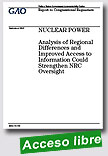 |
Nuclear Power: Analysis of Regional Differences and Improved Access to Information Could Strengthen NRC Oversight
Government Accountability Office (GAO-US), September 27, 2013, 102 p.
The 2011 disaster at Japan's Fukushima Daiichi Nuclear Power Plant demonstrated that unexpected nuclear accidents with extreme consequences can occur and, thus, heightened concerns about NRC's ability to oversee the safety of U.S. commercial nuclear power reactors. NRC oversees safety through multiple processes, such as physically inspecting reactors and also responding to signs of declining performance
|
(i.e., findings) or violations of its requirements.
GAO was asked to review NRC's oversight of the U.S. nuclear power industry. This report examines (1) how NRC implements its processes for overseeing the safety of commercial nuclear power reactors; (2) the extent to which NRC consistently identifies and resolves findings through these processes; and (3) NRC's methods for developing lessons learned to improve its oversight and challenges, if any, NRC faces in doing so. GAO reviewed NRC policies and guidance; visited five nuclear power plants located in multiple NRC regions; analyzed NRC data on findings, violations, licensee performance, and inspection hours; interviewed NRC officials and industry representatives; and observed demonstrations of NRC's database search tools.
GAO recommends, among other things, that NRC analyze the causes of differences in identifying and resolving findings across regional offices and address these differences, and that it improve its database search tools. NRC agreed with GAO's recommendations.
Highlights
Extraído de: http://www.gao.gov/products/GAO-13-743
|
 |
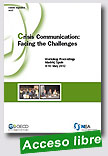
|
Crisis Communication: Facing the Challenges
Nuclear Energy Agency (NEA), 2013, 240 p.
As manifested by an increasingly globalised media, a nuclear accident anywhere quickly becomes a potential concern for people everywhere. It is therefore of prime importance that nuclear regulators’ communication strategies take into consideration the expectations and concerns of the public and provide sound information not only for the people of the affected country, but also for citizens worldwide. Public trust is a key element in being able to do so effectively and of particular |
importance when there are consequences for people or the environment. International co-operation can play a fundamental role in helping to improve crisis communication on national and global scales in the event of a nuclear accident or radiological emergency. These proceedings contain the papers, recommendations and conclusions of the workshop, which was attended by over 180 experts from 27 countries and 6 international organisations.
Extraído de:
http://www.oecdnea.org/tools/publication?query=&div=&lang=
&period=6m&sort=title&filter=1#p7067
|
 |
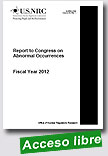 |
Report to Congress on Abnormal Occurrences – Fiscal Year 2012 (NUREG-0090, Volume 35, Revision 1)
United States Nuclear Regulatory Commission, August 2013, 77 p.
Section 208 of the Energy Reorganization Act of 1974, as amended (Public Law 93-438), defines an "abnormal occurrence" (AO) as an unscheduled incident or event that the U.S. Nuclear Regulatory Commission (NRC) determines to be significant from the standpoint of public health or safety. The Federal Reports Elimination and Sunset Act of 1995 (Public Law
|
104-66) requires that the NRC report AOs to Congress annually.
This report describes four events involving NRC licensees that the NRC identified as AOs during fiscal year (FY) 2012 based on the criteria defined in Appendix A, "Abnormal Occurrence Criteria and Guidelines for Other Events of Interest." The first event at an NRC-licensed facility was an occurrence at a commercial nuclear power plant. The other three events occurred at NRC-licensed medical institutions and are medical events, as defined in Title 10 of the Code of Federal Regulations (10 CFR) Part 35, "Medical Use of Byproduct Material."
In addition, this report describes 18 events that Agreement States identified as AOs during FY 2012, based on the criteria in Appendix A to this report. Agreement States are those States that have entered into formal agreements with the NRC, pursuant to Section 274 of the Atomic Energy Act of 1954 (AEA) (Public Law 83-703) to regulate certain quantities of radioactive material within their borders. Currently, there are 37 Agreement States. The first Agreement State licensee event involved radiation exposure to an embryo/fetus and the second event involved an exposure to a radiographer. The other 16 Agreement State licensee events were medical events, as defined in 10 CFR Part 35. Two of the 16 Agreement State licensee medical events involve multiple medical events at the same treatment facility; however, one event report is provided for each of these two events.
Appendix A to this report presents the NRC's criteria for selecting AOs, as well as the guidelines for selecting "other events of interest." Appendix B, "Updates of Previously Reported Abnormal Occurrences," provides updated information for three events reported in the FY 2011 "Report to Congress on Abnormal Occurrences." The update involves a radiation exposure event at Caribbean Inspection & NDT Services, Inc., in Port Lavaca, Texas; a commercial nuclear power plant event at Browns Ferry Nuclear Plant, Unit 1, in Athens, Alabama; and a medical event at Lovelace Medical Clinic in Albuquerque, New Mexico. During FY 2012, the NRC identified eight additional items as meeting the guidelines for inclusion in Appendix C, "Other Events of Interest." Five of these events occurred at nuclear power plants, one event involved a medical treatment device, one event involved a lost well logging source, and the last event involved a fuel cycle facility. Appendix D, "Glossary," presents definitions of terms used throughout this report. Appendix E, "Conversion Table," presents conversions commonly used when calculating doses.
Extraído de:
http://www.nrc.gov/reading-rm/doc-collections/nuregs/staff/sr0090/v35/r1/
|
 |
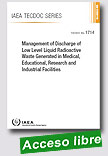 |
Management of Discharge of Low Level Liquid Radioactive Waste Generated in Medical, Educational, Research and Industrial Facilities
IAEA TECDOC, 2013, 51 p.
This publication is intended for decision makers in countries generating radioactive effluents in the areas of medicine, education, research and industry with non-nuclear power applications. It provides guidance and information on how to implement and optimize their radioactive effluent management practices and describes methodologies, criteria and options for
|
the selection of appropriate technology for the discharge of liquid radioactive effluents into the sewer system. The report reviews both technical and non-technical factors important for decision making and planning, and for the implementation of the most appropriate process design for effluent discharges at the country and facility levels. It makes practical recommendations for the selection of decay storage arrangements for different scales of radioactive effluent generation.
Extraído de:
http://www-pub.iaea.org/MTCD/Publications/PDF/TE-1714_web.pdf
|
 |
|
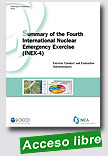
|
Summary of the Fourth International Nuclear Emergency Exercise (INEX-4)
Exercise Conduct and Evaluation Questionnaires Nuclear Energy Agency (NEA), 29/07/13, 48 p.
The International Nuclear Emergency Exercise (INEX) series, organised under the OECD Nuclear Energy Agency (NEA) Working Party on Nuclear Emergency Matters (WPNEM), has proven successful in testing, investigating and improving national and international response arrangements for nuclear accidents and radiological emergencies. Early INEX exercises focused on the national and international aspects of early phase
|
management of nuclear power plant emergencies. Starting with INEX-3 (2005-2006), the international community began looking at issues concerning longer-term consequence management. In 2008, the WPNEM started preparing the INEX-4 series, which was conducted in 2010-2011 and addressed consequence management and transition to recovery in response to malicious acts involving the release of radioactive materials in an urban setting. The goal of INEX-4 was to provide a basis for enhancing emergency management through the exchange of exercise experiences from participating countries and the identification of good practices and common issues. This summary report provides general outcomes based on country responses to the INEX-4 evaluation questionnaire and suggests areas of focus for future consideration.
Extraído de:
http://www.oecdnea.org/tools/publication?query=&div=&lang=
&period=6m&sort=title&filter=1#p7143
|
| |
|
|
| |
| |
|
|
|
| |
|
|
|
| |
|
|
|
| |
|
|
|
|
|
